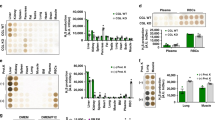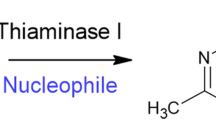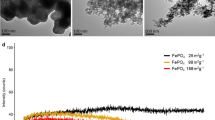Abstract
Objective:
We tested whether homocysteine is formed from methionine and other thioethers in vitro and in vivo, because methionine can be chemically demethylated to homocysteine.
Design:
In in vitro studies, chemical conversions of thioethers (methionine, S-adenosylhomocysteine and cystathionine) into homocysteine were measured under various aerobic conditions. In humans, oral methionine (0.17 mmol/kg body weight) loading tests with and without an oral iron dose (ferrous sulfate, 13 μmol/kg) were performed.
Setting:
A university setting in Birmingham, AL, USA.
Subjects:
A total of five healthy adult subjects volunteered.
Results:
The in vitro incubation of methionine, S-adenosylhomocysteine or cystathionine with chelated iron resulted in the formation of homocysteine. These conversions were iron- and pH-dependent (pH optima between 5.0 and 6.0) and it was also chelator-dependent. In humans, oral methionine loading tests resulted in a 45% increase in the area-under-the-curve for plasma total homocysteine concentrations, when iron was given together with methionine.
Conclusion:
Our data suggest that iron-dependent chemical formation of homocysteine can occur in vivo, and contribute to the plasma total homocysteine pool, since this formation can occur ceaselessly. We hypothesize that plasma total homocysteine concentrations reflect, in part, non-protein-bound iron in the body.
This is a preview of subscription content, access via your institution
Access options
Subscribe to this journal
Receive 12 print issues and online access
$259.00 per year
only $21.58 per issue
Buy this article
- Purchase on Springer Link
- Instant access to full article PDF
Prices may be subject to local taxes which are calculated during checkout



Similar content being viewed by others

References
Aisen P, Cohen G, Kang JO (1990). Iron toxicosis. Inter Rev Exp Pathol 31, 1–46.
Bønna KH, Njølstad I, Ueland PM, Schirmer H, Tverdal A, Steigen T et al. (2006). Homocysteine lowering and cardiovascular events after acute myocardial infarction. N Engl J Med 354, 1578–1588.
Bothwell TH, Charlton RW, Motulsky AG (1995). Hemochromatosis. In: Scriver CR, Beaudet AL, Sly WS, Valle D, eds. The Metabolic and Molecular Basis of Inherited Disease, 7th edn, New York: McGraw-Hill. pp 2237–2269.
Brattström L, Wilcken DEL (2000). Homocysteine and cardiovascular disease: cause or effect? Am J Clin Nutr 72, 315–323.
Clarke R, Daly L, Robinson K, Naughten E, Cahalane S, Fowler B et al. (1991). Hyperhomocysteinemia: an independent risk factor for vascular disease. N Eng J Med 324, 1149–1155.
Daher R, Van Lente F (1995). Relationship of increased homocysteine with copper, iron, and zinc concentrations in serum. Irish J Med Sci 164 (suppl. 15), 21 (abstract).
Davey Smith G, Ebrahim S (2005). Folate supplementation and cardiovascular disease. Lancet 366, 1679–1681.
Ditschield B, Fünfstück R, Busch M, Schubert R, Gerth J, Jahreis G (2005). Effect of L-methionine supplementation on plasma homocysteine and other free amino acids: a placebo-controlled double-blind cross-over study. Eur J Clin Nutr 59, 768–775.
Facchini FS, Saylor KL (2002). Effect of iron depletion on cardiovascular risk factors. Studies in carbohydrate-intolerant patients. Ann NY Acad Sci 967, 342–351.
Harrison PM, Arosio P (1996). The ferritins: molecular properties, iron storage function and cellular regulation. Biochim Biophys Acta 1275, 161–203.
Heart Outcomes Prevention Evaluation (HOPE) 2 Investigators (2006). Homocysteine lowering with folic acid and B vitamins in vascular disease. N Engl J Med 354, 1567–1577.
Lange H, Suryapranata H, De Luca G, Böner C, Dille J, Kallmayer K et al. (2004). Folate therapy and in-stent restenosis after coronary stenting. N Eng J Med 350, 2673–2681.
Liem A, Reynierse-Buitenwerf GH, Zwinderman AH, Jukema JW, van Veldhuisen DJ (2003). Secondary prevention with folic acid: effects on clinical outcomes. J Am Coll Cardiol 41, 2105–2113.
March J (1968). Advanced organic chemistry: reactions, mechanisms, and structure. New York: McGraw-Hill. pp 344–345.
Mattioli AV, Bonetti L, Zennaro M, Bertoncelli P, Mattioli G (2005). Acute myocardial infarction in young patients: nutritional status and biochemical factors. Int J Cardiol 101, 185–190.
Nalini S, Ramakrishna BS, Mohanty A, Balasubramanian KA (1992). Hydroxyl radical formation in human gastric juice. J Gastroenterol Hepatol 7, 497–501.
Pennington JAT (1998). Bowes & Church's food values of portion commonly used. Philadelphia, PA: Lippincott-Raven. pp 105–125.
Petrat F, de Groot H, Rauen U (2001). Subcellular distribution of chelatable iron: a laser scanning microscopic study in isolated hepatocytes and liver endotherial cells. Biochem J 356, 61–69.
Ponka P, Beaumont C, Richardson DR (1998). Function and regulation of transferrin and ferritin. Sem Hematol 35, 35–54.
Refsum H, Ueland PM, Nygård O, Vollset SE (1998). Homocysteine and cardiovascular disease. Annu Rev Med 49, 31–62.
Roest M, van der Schouw YT, de Valk B, Marx JJM, Templeman MJ, de Groot PG et al. (1999). Heterozygosity for a hereditary hemochromatosis gene is associated with cardiovascular death in women. Circulation 100, 1268–1273.
Shimakawa T, Nieto FJ, Malinow MR, Chambless LE, Schreiner PJ, Szklo M (1997). Vitamin intake: a possible determinant of plasma homocyst(e)ine among middle-aged adults. Ann Epidemiol 7, 285–293.
Stekol JA (1957). Preparation and determination of sulfur amino acids and related compounds. Method Enzymol 3, 578–600.
Sullivan JL (2006). Is homocysteine an iron-dependent cardiovascular risk factor? Kidney Int 69, 642–644.
Tamura T, Bergman SM, Morgan SL (1998). Homocysteine, B vitamins, and vascular-access thrombosis in patients treated with hemodialysis. Am J Kidney Dis 32, 475–481.
Tamura T, Johnston KE, Bergman SM (1996). Homocysteine and folate concentrations in blood from patients treated with hemodialysis. J Am Soc Nephrol 7, 2414–2418.
Toole JF, Malinow MR, Chambless LE, Spence JD, Pettigrew LC, Howard VJ et al. (2004). Lowering homocysteine in patients with ischemic stroke to prevent recurrent stroke, myocardial infarction, and death. The Vitamin Intervention for Stroke Prevention (VISP) randomized controlled trial. JAMA 291, 565–575.
Ubbink JB, Vermaak WJH, van der Merwe A, Becker PJ (1992). The effect of blood sample aging and food consumption on plasma total homocysteine levels. Clin Chim Acta 207, 119–128.
Zheng H, Cable R, Spencer B, Votto N, Katz SD (2005). Iron stores and vascular function in voluntary blood donors. Arterioscler Thromb Vasc Biol 25, 1577–1583.
Zheng H, Huang X, Zhang Q, Katz SD (2006). Iron sucrose augments homocysteine-induced endothelial dysfunction in normal subjects. Kidney Int 69, 679–684.
Author information
Authors and Affiliations
Corresponding author
Additional information
Contributors: Both authors (JEB and TT) contributed in designing and performing the experiments and writing the manuscript.
Rights and permissions
About this article
Cite this article
Baggott, J., Tamura, T. Iron-dependent formation of homocysteine from methionine and other thioethers. Eur J Clin Nutr 61, 1359–1363 (2007). https://doi.org/10.1038/sj.ejcn.1602665
Received:
Revised:
Accepted:
Published:
Issue Date:
DOI: https://doi.org/10.1038/sj.ejcn.1602665
Keywords
This article is cited by
-
Impacts of dietary supplementation with nano-iron and methionine on growth, blood chemistry, liver biomarkers, and tissue histology of heat-stressed broiler chickens
Tropical Animal Health and Production (2022)
-
Demethylation of methionine and keratin damage in human hair
Amino Acids (2018)


